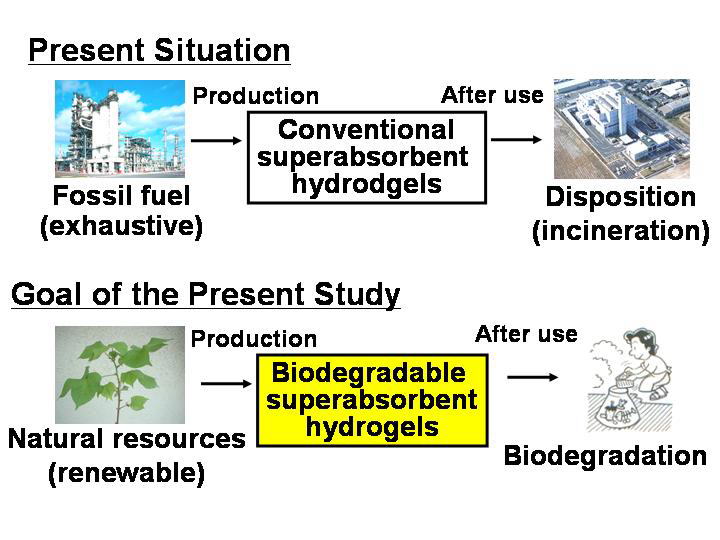|
|
Research
|
Development of eco-friendly polymers useful in our daily life is one of
the significant challenges for the realization of a sustainable society.
1. Background
In 20th century, various kinds of synthetic plastics have been developed
and produced, which made our life so comfortable, clean, and safe. On the
other hand, synthetic plastics possess many problems to solve. They are
produced from fossil fuel, which is exhaustive. They have no biodegradability,
so they remain for a long time when disposed by landfill. They may cause
increase of carbon dioxide concentration in the atmosphere, when disposed
by incineration. So, synthetic plastics are one of the significant and symbolic material of the modern society. One possible solution is development of green polymers, such as poly(lactic
acid). They are produced from natural resources such as corn starch, which
are renewable. They have biodegradability which can be disposed in sewage
plant or compost.

2. Research Topic (a) Development of eco-friendly superabsorbent hydrogels
Superabsorbent hydrogels are extensively used in many applications such
as hygiene products, agriculture, food, medical, and so on. The present situation
of superabsobent hydrogels are similar to that of synthetic plastics. They
are produced from petroleum, and after use, they are incinerated in Japan,
in spite of containing large amount of water. So development of "green"
superabsorbent hydrogels is a very important theme to achieve. Cotton cellulose
is promising candidate for their main chain, because it is abundantly produced
every year, its molecular weight is extremely high, and it has excellent
biodegradability. So we have been studying the development of superabsorbent hydrogels based on polysaccharides such as cotton cellulose, chitin, starch, and so on. Various kinds of novel biodegradable superabsorbent hydrogels have been successfully obtained from these polysaccharides.

・Left: teabag with o.2g sample based on cotton cellulose.
・Right: blank teabag (without sample).
3. Research Topic (b) Utilization of sea lettuce proliferating at Hakata bay
Wajiro-higata tideland, east area of Hakata bay, is one of the most popular
stopovers for migratory birds. Recently, a plague of sea lettuce has been seen every summer, which may not only destroy the scenery but also exert a bad influence on
the ecological system. Fukuoka city collects it by use of special boat. The collected sea lettuce
is disposed by landfill or incineration, because its application has not
been found yet. We have investigated the production of life-related materials
such as detergent, paper and green composites from sea lettuce. Environmental
load of transportation will be reduced when we achieve the goal, as shown
below.

・Left: Present situation (material circulation in global scale).
・Right: Goal (material circulation in regional scale).
|
|
|
|

